by pmdavis | Feb 5, 2016
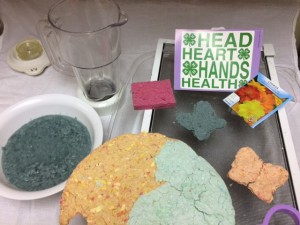
Grow Card Supplies and products
4-H literally got its start with gardening. The very first 4-H Clubs focused on growing tomatoes and corn for boys and canning for girls. Many youth and volunteers still enjoy gardening projects today. One great curricula that is used is the Junior Master Gardening Program. This program allows youth to enhance their life using gardening as the spark of interest. Gardening enriches youth’s lives, promotes good health, gives a sense of environmental awareness and saves money.
One of the activities I enjoy doing with youth combines gardening with recycling and crafting. As a group we will make our own paper grow cards or ornaments that have seeds embedded in them. Once the cards are dry, we deliver them as a service project. The cards are fun and inexpensive to make and are a perfect activity for your next club meeting! Try making them as valentines for Valentines Day. For beginners, we recommend growing tomatoes, lettuce, peppers, cucumbers, basil, chives, or parsley. Not into vegies? Try starting marigolds, cosmos, sunflowers, zinnias, pansies, or petunias.
Download our detailed factsheet with photos and directions. This activity is great for any occasion when you need a card or small gift. You can use as party favors by making them into ornaments using raffia to hang them from a tree or gift bag. You can take them to a nursing home, veterans center, hospital or other site as a service project for your club. Just be sure to share with the individual that they need to plant your card or ornament. It is a great way to help youth share their joy of gardening with others.
Other Extension gardening resources include:
• Florida Vegetable Gardening Guide
If you have a green thumb, consider going “totally green” as a 4-H gardening volunteer! 4-H needs caring adults like you to share their knowledge and passion for gardening with the next generation. Through the 4-H gardening project, youth not only learn gardening knowledge and skills, they also learn responsibility, teamwork, and other life skills that will help them grow up to be compassionate and competent citizens. To get involved, contact your local UF IFAS Extension Office, or visit Florida 4-H.
by Whitney Cherry | Dec 25, 2015
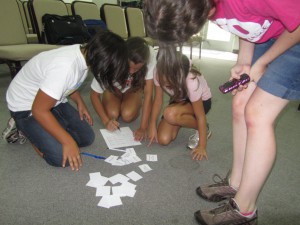
Enjoy a high-energy game of exercise bingo as you race other teams to see who can win! This game is available at your local extension office.
The New Year is upon us, and it is so fun to celebrate its coming with our families. Do you have a favorite New Year’s Tradition? If not, there is still time to plan one for this year! Here are a few fun and easy ideas to inspire you:
- New Year’s Eve Bonfire– roast hotdogs and marshmallows and enjoy hot chocolate by the fire. More family friendly campfire recipes
- Game Tournament– set up a tournament of games. You can play Minute to Win-It Style games, board games, or even electronic/video games. Each hour until midnight, let a family member choose their favorite game to play.
- Balloon Countdown– You will need a balloon for each hour of the countdown, depending on when you start. I recommend starting at 6PM, so you would need six balloons. Place a slip of paper with a craft, game or activity written on it. Place a slip in each balloon, then blow up the balloons and label each one with a number, representing each hour in the countdown until midnight. For example, at 6PM, have a family member pop the balloon with the number six on it, and then the family would do the activity listed on the slip of paper. Continue to pop balloons until midnight! Some of the activities you might include are: make paper hats, write down New Year’s Resolutions, make noisemakers, enjoy fireworks, etc.
- Progressive Hors d ’Oeuvres– this sounds fancy, but is really simple. Just prepare your family’s favorite snacks. Each hour, enjoy a different snack until midnight.
- Family Movie Night is another inexpensive favorite. Make homemade pizza or pop popcorn and enjoy a night in with your family.
- Fireworks can also be a fun activity, but be sure to read our tips on firework safety beforehand.
- Balloon Drop– a nice alternative to fireworks. Use masking tape to tape together 2 lengths of netting. Extend the tape to make a “rip cord.” Fill with balloons and confetti and tape to the ceiling (use painter’s tape so you do not damage the paint). At the stroke of midnight, pull on the rip cord and enjoy a cascade of celebratory balloons and confetti!
- And finally, you can go all in and recreate your favorite game shows. Imagine win-lose-or draw, family feud, the price is right…the possibilities are endless.
Do you have a favorite family New Year’s Eve tradition? If so, share in the comments! We want to thank you for another great year in 4-H! If you are not currently a 4-H member or volunteer, contact your local UF IFAS County Extension Office for more information, or visit http://florida4h.org for more information.
by Jenny Savely | Dec 19, 2015
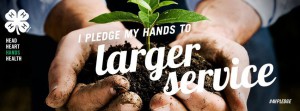
Clear evidence of mastering a skill is being able to employ it in one’s everyday life. Knowledge is only as good as how we are able to use it. 4-H dedicates itself to educating youth with research based curriculum not only for their own benefit but also so they can share that knowledge with others. When we “pledge our hands to larger service”, this can take on many forms. It may look like teaching youth in a community center about robotics or gardening, making meals for the military and first responders, or cleaning up trash in local parks. In all our service, it is important that regardless of what this looks like that we focus on meeting a need in our community. Identifying these needs is sometimes difficult if they are not part of what we see around us regularly. Talking to people who do not have the same life experiences we do is a good way to start seeing the world in a different way and thinking about ways you can help others who haven’t had the same opportunities. In Escambia County, around 30% of our youth population lives in poverty (US Census). Outcomes of living in poverty are hunger, poor housing, poor health, and lower educational scores, just to name a few. Our 4-Hers are learning to use the skills they have gained in 4-H in creative ways to help address some of these issues. One club has received a grant to raise a hog that a youth will show and have processed so the meat can be included in food boxes for local families. Another club raised funds to help support the Council on Aging to provide air conditioning units to the elderly, who are more likely to be impoverished, during the hot summer months.
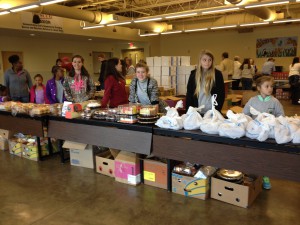
Escambia County 4-Hers assemble food boxes for local families at this year’s Farm to City event.
Whether poverty, pollution, safety, education, healthcare, or another issue is one that effects your community, the skills youth learn through 4-H can help address it. Not only does this help those around us live healthier and more productive lives, but it helps those who serve connect to their community and learn to give back. As with all 4-H projects, our goal is to help youth become more engaged and knowledgeable citizens that contribute to their world in positive ways. We encourage our youth to embody the spirit of generosity all year long, but during this season, be sure to explore the needs in your community you can help to change, even in the smallest way. If you need help thinking of how to best give back, contact your local 4-H Agent, local non-profits, or look up your county’s information in a database such as the US Census’ QuickFacts (http://quickfacts.census.gov/qfd/states/12000.html) and think about what kinds of problems might arise from the information you find there.
4-H also offers many Leadership and Citizenship projects that can help youth navigate assessing the needs of their community and putting their skills to use. You can find a few such project guides at the following links:
If you are interested in helping guide the next generation to be compassionate, active citizens for tomorrow, consider becoming a 4-H Volunteer. 4-H offers a wide variety of roles to fit your interests and schedule. Visit http://florida4h.org or contact your local UF IFAS Extension Office.
US Census. 2015. American Community Survey 2009-2013 five-year estimates, Children Characteristics: Escambia County, FL. Accessed November 18, 2015.

by Melanie Taylor | Dec 11, 2015
 The holidays are often filled with time-honored traditions that include some of our favorite meals and foods. As you celebrate, think of little changes you can make this holiday season to create healthier meals and active days. An added bonus, these small changes may help you to avoid those extra holiday pounds we all fear each year. Happy Cooking!
The holidays are often filled with time-honored traditions that include some of our favorite meals and foods. As you celebrate, think of little changes you can make this holiday season to create healthier meals and active days. An added bonus, these small changes may help you to avoid those extra holiday pounds we all fear each year. Happy Cooking!
In the Kitchen:
• For gravies or sauces — if you are making pan gravy, first skim the fat off pan drippings. For cream or white sauces, use fat-free (skim) milk and soft tub or liquid margarine.
• For dressings or stuffing — add low-sodium broth or pan drippings with the fat skimmed off instead of lard or butter. Use herbs and spices and a whole grain bread for added flavor.
• For biscuits — use vegetable oil instead of lard or butter and fat-free (skim) milk or 1 percent buttermilk instead of regular milk.
• For greens — use skin-free smoked turkey, liquid smoke, fat-free bacon bits, or low-fat bacon instead of fatty meats.
• For sweet potato pie — mash sweet potato with orange juice concentrate, nutmeg, vanilla, cinnamon, and only one egg. Leave out the butter.
• For cakes, cookies, quick breads, and pancakes — use egg whites or egg substitute instead of whole eggs. Two egg whites can be substituted in many recipes for one whole egg.
• Use unsweetened applesauce or mashed ripe bananas instead of butter.
• Try cutting the amount of sugar listed in recipes in half.
• Use spices to add flavor such as cinnamon, allspice, or nutmeg instead of salt.
• Try baked apples with cinnamon and a sprinkle of sugar instead of apple pie.
• Invite your guests to make their own parfait with colorful sliced fruit and low-fat yogurt.
For meats and poultry (chicken and turkey):
• Trim away all of the visible fat from meats and poultry before cooking.
• Take off poultry skin before eating.
• Broil, grill, roast, poach, or boil meat, poultry, or fish instead of frying.
• Drain off any fat that appears during cooking.
• Chill meat and poultry broth until fat becomes solid. Skim off fat before using the broth.
• Skip or limit the breading on meat, poultry, or fish. Breading adds fat and calories. It will also cause the food to soak up more fat during frying.
• Choose and prepare foods without high fat sauces or gravies.
When Shopping:
• Start with a lean choice.
• The leanest beef cuts include round steaks and roasts (round eye, top round, bottom round, round tip), top loin, top sirloin, and chuck shoulder and arm roasts.
• The leanest pork choices include pork loin, tenderloin, center loin, and ham.
• Boneless skinless chicken breasts and turkey cutlets are the leanest poultry choice.
Use the food label to help you choose
• Choose extra lean ground beef. The label should say at least “90% lean.” You may be able to find ground beef that is 93% or 95% lean.
• Processed meats such as hams, sausages, frankfurters, and luncheon or deli meats have added sodium. Check the ingredient and Nutrition Facts label to help limit sodium intake.
• Fresh chicken, turkey, and pork that have been enhanced with a salt-containing solution also have added sodium. Check the product label for statements such as “self-basting” or “contains up to __% of __.”
• Lower fat versions of many processed meats are available. Look on the Nutrition Facts label to choose products with less fat and saturated fat.
De-Saturate
• Use a nonstick pan with vegetable cooking oil spray or a small amount of liquid vegetable oil instead of lard, butter, shortening, or other fats that are solid at room temperature.
Enjoy the Food, Fun, Friends and Family!
Cheers to Good Health
• Quench your thirst with low-calorie options. Drink water with lemon or lime slices. Offer seltzer water with a splash of 100% fruit juice.
Be the Life of the Party
• Laugh, mingle, dance, and play games. Focus on fun and enjoy the company of others.
Give to Others
• Spend time providing foods or preparing meals for those who may need a little help. Give food to a local food bank or volunteer to serve meals at a shelter during the holiday season. Giving back is a great mood booster.
Make Exercise a Part of the Fun
• Make being active part of your holiday tradition. Have fun walking and talking with family and friends after a holiday meal. Give gifts that encourage others to practice healthy habits such as workout DVDs, running shoes, and reusable water bottles.
Enjoy the Leftovers
• Create delicious new meals with your leftovers. Add turkey to soups or salads. Use extra veggies in omelets, sandwiches, or stews. The possibilities are endless!
Be sure your family and friends enjoy the food and fun, but focus on the time together. Remember this season is all about the memories, not just the food. You will feel better and enjoy your holiday time with less worry if you focus on staying healthy this season.
Source: USDA United States Department of Agriculture – www.MyPlate.gov
by Monica Brinkley | Jul 10, 2015
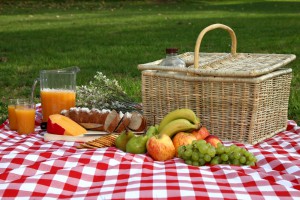
Keep your picnics safe this summer!
Summer months are a great time for picnicking with family and friends. Flies and other insects can be rather annoying, but the “bugs” you can’t see can be extremely harmful. Bacteria love the warm humid weather and grow more quickly in the summer than any other time of the year. The number of people who get sick during the hot months of the year is much greater. So read over the following tips to beat bacteria at your summer picnic.
Keep it Clean!
■ Find out if your picnic destination has a source of safe drinking water. If not, bring water or moist towelettes for cleaning hands and surfaces.
■ Always wash your hands with warm, soapy water for 20 seconds before and after handling food. Unwashed hands are a major cause of foodborne illness. Use moist towelettes if hand-washing facilities are not available.
■ Be sure raw meat and poultry are wrapped securely to prevent their juices from cross-contaminating other foods in the cooler.
■ Pack enough clean utensils for both eating and serving food. Don’t use the same utensil or platter for raw and cooked meat and poultry. Disposable plates and utensils help prevent cross-contamination.
■ Keep foods covered to prevent insects from enjoying your lunch!
Keep Cold Foods Cold!
■ Keep perishable foods cool by transporting them in an insulated cooler with plenty of ice or frozen gel packs. Perishable foods include meat, poultry, seafood, eggs, dairy products, pasta, rice, cooked vegetables, and peeled and cut fruits and vegetables.
■ Pack the cooler just before leaving home. Foods chilling in your refrigerator should be placed directly in your cooler with ice or frozen gel packs.
■ Avoid frequently opening coolers containing perishable food. It’s a good idea to store beverages and perishable foods in separate coolers.
Keep the cooler in an air-conditioned vehicle during travel and in the shade at the picnic site.
Some other resources to help or share:
UF IFAS Picnic Safety Video
UF IFAS Food Safety Factsheet for Potlucks
Fun Picnic Ideas to Try this Summer
Do you have a passion or skills that you would like to pass on to the next generation of parents, employees, civic leaders, and decision makers? 4-H needs caring adults from a wide variety of backgrounds, skills and experiences. For more information, contact your local UF IFAS Extension Office, or visit http://florida4h.org/volunteers.
Your opinion matters! Please take this short survey to help us improve our blog https://ufl.qualtrics.com/SE/?SID=SV_3gtLKjqia3F75QN
by Stefanie Prevatt | May 29, 2015
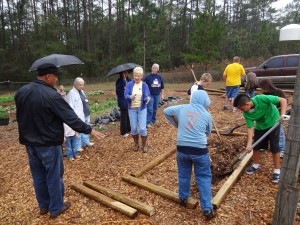
Photo credit: Zulema Wibmer, 4-H Program Assistant, Leon County 4-H Office
Garden-based education is taking America by storm. While this is concept dates as far back as the seventeenth century, it certainly feels like the popular movement of the day. 4-H has been using garden based education since 1902 with tomato and corn clubs to teach life skills such as resiliency, planning and organizing, and communication. These same skills are necessary to become a successful entrepreneur:
Resiliency: the ability to try again after failure. A garden is the perfect place for youth to test ideas or try new things. As adults, we know that sometimes the key to success is (safe) failure! If you are using a garden your classroom, allow creative experimentation. Success will build on itself and trials that missed the mark will make for more lively discussion and group cohesion.
Planning/organizing: the process of figuring out what to do (planning) and how to do it (organizing). Whether you are starting new or continuing an existing project, allowing the expression of youth ideas and goals – followed by their help implementing these plans – is crucial to your project’s success. Remember, we can grow all the vegetables in the world, but if the youth don’t learn or feel a sense of accomplishment related to the project, all we did was grow vegetables.
Communication: the exchange of thoughts, messages, or information, as by speech, signals, writing, or behavior. In today’s tech savy world, we are losing the ability to communicate in person and in writing. You have a unique opportunity to work with your group together, or as individuals, to discuss (or write descriptively) about your garden.
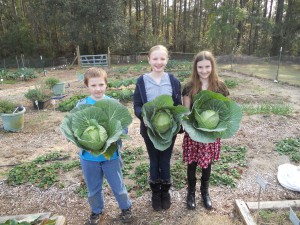
Photo credit: Zulema Wibmer, 4-H Program Assistant, Leon County 4-H Office
UF IFAS Extension offers many resources to help both youth and adults become entrepreneurs in the food industry. Food entrepreneurship has really exploded with the Cottage Food Law. Many County Extension Offices offer workshops and seminars on food entrepreneurship, and there are also some great online resources to help you get started:
If you have a green thumb, consider going “totally green” as a 4-H gardening volunteer or Master Gardener. 4-H needs caring adults like you to share their knowledge and passion for gardening with the next generation. Through the 4-H gardening project, youth not only learn gardening knowledge and skills, they also learn responsibility, teamwork, and other life skills that will help them grow up to be compassionate and competent citizens. To get involved, contact your local UF IFAS Extension Office, or visit http://florida4h.org./volunteers.
Your opinion matters! Please provide feedback on this short survey to help us improve our blog: https://ufl.qualtrics.com/SE/?SID=SV_3gtLKjqia3F75QN








